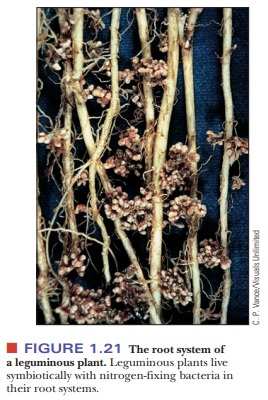Chapter: Biochemistry: Biochemistry and the Organization of Cells
Did eukaryotes develop from prokaryotes?
Did eukaryotes develop from prokaryotes?
The
complexity of eukaryotes raises many questions about how such cells arose from
simpler progenitors. Symbiosis plays a large role in current theories of the
rise of eukaryotes; the symbiotic association between two organisms is seen as
giving rise to a new organism that combines characteristics of both the
origi-nal ones. The type of symbiosis called mutualism is a relationship that benefits both species involved, as
opposed to parasitic symbiosis, in
which one species gains at the other’s expense. A classic example of mutualism
(although it has been questioned from time to time) is the lichen, which
consists of a fungus and an alga. The fungus provides water and protection for
the alga; the alga is photosynthetic and provides food for both partners.
Another example is the root-nodule system formed by a leguminous plant, such as
alfalfa or beans, and anaerobic nitrogen-fixing bacteria (Figure 1.21).

The plant gains useful compounds
of nitrogen, and the bacteria are protected from oxygen, which is harmful to
them. Still another example of mutualistic symbiosis, of great practical
interest, is that between humans and bacteria, such as Escherichia coli, that live in the intestinal tract. The bacteria receive
nutrients and protection from their immediate environment. In return, they aid
our digestive process. Without beneficial intestinal bacteria, we would soon
develop dysentery and other intestinal disorders. These bacteria are also a
source of certain vitamins for us, because they can synthesize these vitamins
and we cannot. The disease-causing strains of E. coli that have been in the news from time to time differ
markedly from the ones that naturally inhabit the intestinal tract.
Related Topics